Construction of Rural Multifunctional Landscape Corridor Based on MSPA and MCR Model—Taking Liukeng Cultural and Ecological Tourism Area as an Example
Abstract
1. Introduction
2. Research Area and Methods
2.1. Study Area Overview
2.2. Data Sources and pre-Processing
2.3. MSPA-Based Ecological Source Site Identification
2.4. MCR-Based Resistance Surface Construction
2.5. Evaluation of Landscape Corridor Network Structure
2.6. Optimization of Landscape Corridor Network
3. Analysis of Results
3.1. Identification and Extraction of Ecological Source Sites
3.1.1. MSPA-Based Landscape Analysis
3.1.2. Extraction Analysis of Important Ecological Source Sites
3.2. Landscape Corridor Network Construction Analysis
3.2.1. Construction of Resistance Surface Based on MCR Model
3.2.2. Extraction and Identification of Landscape Corridors
3.2.3. Landscape Corridor Network Connectivity Analysis
3.3. Optimization of Landscape Corridor Network
3.3.1. Adding Key Ecological Steppingstones
3.3.2. Connecting Rural Human Landscape
3.3.3. Restoration of Ecological Breakpoints
4. Discussion
4.1. Identification and Extraction Analysis of Ecological Source Sites
4.2. Analysis of Landscape Corridor Network Construction
4.3. Optimization Analysis of the Landscape Corridor Network
5. Conclusions
Author Contributions
Funding
Institutional Review Board Statement
Informed Consent Statement
Data Availability Statement
Conflicts of Interest
References
- Chen, Y. Character Assessment and Planning of Rural Landscape. Ph.D. Thesis, Tsinghua University, Beijing, China, 2012. [Google Scholar]
- Xiong, X.; Tang, X.; Ye, H.; Wang, J.; Liu, L. Traditional Rural Landscape Protection and Control Strategy based on “source-sink” pattern. Geogr. Res. Dev. 2019, 38, 120–125, (In Chinese with an English abstract). [Google Scholar]
- Qiu, J.; Wang, X.; Lu, F.; Ouyang, Z.; Zheng, H. The spatial pattern of landscape fragmentation and its relations with urbanization and socioeconomic developments: A case study of Beijing. Acta Ecol. Sin. 2012, 32, 2659–2669, (In Chinese with an English abstract). [Google Scholar]
- Gao, Y.; Mu, H.; Zhang, Y.; Tian, Y.; Tang, D.; Li, X. Research on construction path optimization of urban-scale green network system based on MSPA analysis method: Taking Zhaoyuan City as an example. Acta Ecol. Sin. 2019, 39, 7547–7556, (In Chinese with an English abstract). [Google Scholar]
- Tang, Q.; Ding, S. A review of multifunctional landscape. Acta Ecol. Sin. 2014, 34, 3151–3157, (In Chinese with an English abstract). [Google Scholar] [CrossRef][Green Version]
- Ji, X. Study on Evolvement and Layout Model of Rural Landscape Pattern in the Context of Urbanization—For Example in Jinjing Town. Ph.D. Thesis, China Agricultural University, Beijing, China, 2014. [Google Scholar]
- Wu, J. Landscape Ecology: Pattern, Process, Scale, and Hierarchy, 2nd ed.; Higher Education Press: Beijing, China, 2007; p. 288. (In Chinese) [Google Scholar]
- Yang, Z.; Jiang, Z.; Guo, C.; Yang, X.; Xu, X.; Li, X.; Hu, Z.; Zhou, H. Construction of ecological network using morphological spatial pattern analysis and minimal cumulative resistance models in Guangzhou City, China. Chin. J. Appl. Ecol. 2018, 29, 3367–3376, (In Chinese with an English abstract). [Google Scholar] [CrossRef]
- Rao, P.; Gavane, A.; Ankan, S.; Ansari, M.F.; Pandit, V.I.; Nema, P. Performance Evaluation of a Green Belt in a Petroleum Refinery: A Case Study. Ecol. Eng. 2004, 2, 77–84. [Google Scholar] [CrossRef]
- Flink, C.A.; Searns, R.M. Greenways; Island Press: Washington, DC, USA, 1993; pp. 175–177. [Google Scholar]
- King, C.C.; Eugster, J.G.; Steiner, F.; Judd, M.; Diamant, R.; Gerdtz, N. Conservation Options for the Blackstone River Valley. Landsc. Urban Plan. 1988, 13, 81–89. [Google Scholar]
- Flink, C.A.; Olka, K.; Searns, R.M. Trails for the Twenty-First Century: Planning, Design, and Management Manual for Multi-Use Trails, 2nd ed.; Island Press: Washington, DC, USA, 2001. [Google Scholar]
- Conine, A.; Xiang, W.-N.; Young, J.; Whitley, D. Planning for Multi-purpose Greenways in Concord, North Carolina. Landsc. Urban Plan. 2004, 68, 271–287. [Google Scholar] [CrossRef]
- Giridharan, R.; Lau, S.S.Y.; Ganesan, S. Urban Design Factors Influencing Heat Island Intensity in High-rise High-density Environments of Hong Kong. Build. Environ. 2007, 42, 3669–3684. [Google Scholar] [CrossRef]
- Xu, F.; Yin, H.; Kong, F.; Xu, J. Developing ecological networks based on mspa and the least-cost path method: A case study in bazhong western new district. Acta Ecol. Sin. 2015, 35, 6425–6434, (In Chinese with an English abstract). [Google Scholar]
- Chen, X.; Chen, W. Construction and evaluation of ecological network in Poyang Lake Eco-economic Zone, China. Chin. J. Appl. Ecol. 2016, 27, 1611–1618, (In Chinese with an English abstract). [Google Scholar] [CrossRef]
- Li, W.; Ma, L.; Zang, Z.; Gao, J.; Li, J. Construction of ecological security patterns based on ecological red line in Erhai Lake Basin of southwestern China. J. Beijing For. Univ. 2018, 40, 85–95, (In Chinese with an English abstract). [Google Scholar]
- Chen, J.; Yin, H.; Kong, F.; Zhang, H.; Wu, J. The complex eco-network development around Taihu Lake, China. Acta Ecol. Sin. 2015, 35, 3113–3123, (In Chinese with an English abstract). [Google Scholar]
- Du, Y.; Hu, Y.; Yang, Y.; Peng, J. Building ecological security patterns in southwestern mountainous areas based on ecological importance and ecological sensitivity: A case study of Dali Bai Autonomous Prefecture, Yunnan Province. Acta Ecol. Sin. 2017, 37, 8241–8253, (In Chinese with an English abstract). [Google Scholar]
- Peng, J.; Guo, X.; Hu, Y.; Liu, Y. Constructing ecological security patterns in mountain areas based on geological disaster sensitivity: A case study in Yuxi City, Yunnan Province, China. Chin. J. Appl. Ecol. 2017, 28, 627–635, (In Chinese with an English abstract). [Google Scholar] [CrossRef]
- Wu, W.; Zhang, M.; Xu, L.; Ou, M. Habitat network optimization based on different network building methods: A case study of Egretta garzetta in the Su-Xi-Chang area. Acta Ecol. Sin. 2016, 36, 844–853, (In Chinese with an English abstract). [Google Scholar]
- Zhu, L.; Liu, H. Landscape Connectivity of Red-Crowned Crane Habitat During Its Breeding Season in Naoli River Basin. J. Ecol. Rural Environ. 2008, 24, 12–16. (In Chinese) [Google Scholar]
- Peng, J.; Zhao, H.; Liu, Y. Urban ecological corridors construction: A review. Acta Ecol. Sin. 2017, 37, 23–30, (In Chinese with an English abstract). [Google Scholar] [CrossRef]
- Ye, H.; Yang, Z.; Xu, X. Ecological Corridors Analysis Based on MSPA and MCR Model—A Case Study of the Tomur World Natural Heritage Region. Sustainability 2020, 12, 959. [Google Scholar] [CrossRef]
- Chen, N.; Kang, S.; Zhao, Y.; Zhou, Y.; Yan, J.; Lu, Y. Construction of ecological network in Qinling Mountains of Shaanxi, China based on MSPA and MCR model. Ying Yong Sheng Tai Xue Bao = J. Appl. Ecol. 2021, 32, 1545–1553. [Google Scholar] [CrossRef] [PubMed]
- Liu, J.; Chen, J.; Yang, Y.; You, H.; Han, X. Construction and Optimization of an Ecological Network in the Yellow River Source Region Based on MSPA and MCR Modelling. Int. J. Environ. Res. Public Health 2023, 20, 3724. [Google Scholar] [CrossRef]
- Zhou, S.; Song, Y.; Li, Y.; Wang, J.; Zhang, L. Construction of Ecological Security Pattern for Plateau Lake Based on MSPA–MCR Model: A Case Study of Dianchi Lake Area. Sustainability 2022, 14, 14532. [Google Scholar] [CrossRef]
- Yang, C.; Guo, H.; Huang, X.; Wang, Y.; Li, X.; Cui, X. Ecological Network Construction of a National Park Based on MSPA and MCR Models: An Example of the Proposed National Parks of “Ailaoshan-Wuliangshan” in China. Land 2022, 11, 1913. [Google Scholar] [CrossRef]
- Hu, C.; Wang, Z.; Wang, Y.; Sun, D.; Zhang, J. Combining MSPA-MCR Model to Evaluate the Ecological Network in Wuhan, China. Land 2022, 11, 213. [Google Scholar] [CrossRef]
- Zhou, Y. Research on Landscape Evaluation and Optimization Strategy of the Village Band in River Valley: Case Study on the Village Band in Shiyan Wuliu Road. Master’s Thesis, Fujian Agriculture and Forestry University, Fuzhou, China, 2018. [Google Scholar]
- Forman, R.T.T. Land Mosaics: The Ecology of Landscapes and Regions; Cambridge University Press: Cambridge, UK, 1995. [Google Scholar]
- Environmental Pattern. Digital Museum of Traditional Chinese Villages. Available online: http://main.dmctv.com.cn/villages/36102510501/History.html (accessed on 7 May 2020).
- Soille, P.; Vogt, P. Morphological segmentation of binary patterns. Pattern Recognit. Lett. 2009, 30, 456–459. [Google Scholar] [CrossRef]
- Saura, S.; Vogt, P.; Velázquez, J.; Gascón, S. Key structural forest connectors can be identified by combining landscape spatial pattern and network analyses. For. Ecol. Manag. 2011, 262, 150–160. [Google Scholar] [CrossRef]
- Qiu, Y.; Chang, Q.; Wang, J. A MSPA-based Planning of Urban Green Infrastructure Network-A Case of Shenzhen. Chin. Landsc. Archit. 2013, 29, 104–108, (In Chinese with an English abstract). [Google Scholar]
- Knaapen, J.P.; Scheffer, M.; Harms, B. Estimating habitat isolation in landscape planning. Landsc. Urban Plan. 1992, 23, 10–16. [Google Scholar] [CrossRef]
- Liu, X.; Shu, J.; Zhang, L. Research on applying minimal cumulative resistance model in urban land ecological suitability assessment: As an example of Xiamen City. Acta Ecol. Sin. 2010, 30, 421–428, (In Chinese with an English abstract). [Google Scholar]
- Fu, B.; Chen, L.; Ma, K.; Wang, Y. Principle and Application of Landscape Ecology; Science Press: Beijing, China, 2011; pp. 60–81. (In Chinese) [Google Scholar]
- Zhang, J.; Qiao, Q.; Liu, C.; Wang, H.; Pei, X. Ecological land use planning for Beijing City based on the minimum cumulative resistance model. Acta Ecol. Sin. 2017, 37, 6313–6321, (In Chinese with an English abstract). [Google Scholar]
- Huang, M.; Yue, W.; Feng, S.; Cai, J. Analysis of spatial heterogeneity of ecological security based on MCR model and ecological pattern optimization in the Yuexi county of the Dabie Mountain Area. J. Nat. Resour. 2019, 34, 771–784, (In Chinese with an English abstract). [Google Scholar] [CrossRef]
- Wang, Q.; Fu, M.; Wei, L. Urban ecological security pattern based on source-sink landscape theory and MCR model: A case study of Ningguo city, Anhui province. Acta Sci. Circumst. 2016, 36, 4546–4554. [Google Scholar]
- Meng, J.; Zhu, L.; Yang, Q. Building ecological security pattern based on land use: A case study of Ordos, Northern China. Acta Ecol. Sin. 2012, 32, 6755–6766. [Google Scholar] [CrossRef]
- Yang, S.; Zou, C.; Shen, W. Construction of ecological security patterns based on ecological red line: A case study of Jiangxi province. Chin. J. Ecol. 2016, 35, 250–258. [Google Scholar]
- Li, Y.; Cai, Y. Security evaluation of land ecology in Hebei province. Acta Sci. Nat. Univ. Pekin. 2007, 43, 784–789. [Google Scholar]
- Liu, X.; Duan, P.; Wang, W.; Cu, C.; Zhang, Z. Research on ecological impact regionalization and restoration strategy in areas of Chengdu heavily impact by earthquake. Res. Environ. Sci. 2010, 23, 711–718. [Google Scholar]
- Li, J.; Meng, J.; Mao, X. MCR based model for developing land use ecological security pattern in farming-pastoral zone: A case study of Jungar Banner, Ordos. Acta Sci. Nat. Univ. Pekin. 2013, 49, 707–715. [Google Scholar]
- Yin, H.; Kong, F.; Qi, Y.; Zhou, X. Developing and optimizing ecological networks in urban agglomeration of Hunan Province, China. Acta Ecol. Sin. 2011, 31, 2863–2874, (In Chinese with an English abstract). [Google Scholar]
- Saura, S.; Pascual-Hortal, L. A new habitat availability index to integrate connectivity in landscape conservation planning: Comparison with existing indices and application to a case study. Landsc. Urban Plann. 2007, 83, 91–103. [Google Scholar] [CrossRef]
- Huang, X.; Wu, C.; You, H.; Xiao, W.; Zhong, S. Construction of rural landscape ecological corridors in water network plain area based on MCR model. Trans. CSAE 2019, 35, 243–251, (In Chinese with an English abstract). [Google Scholar] [CrossRef]
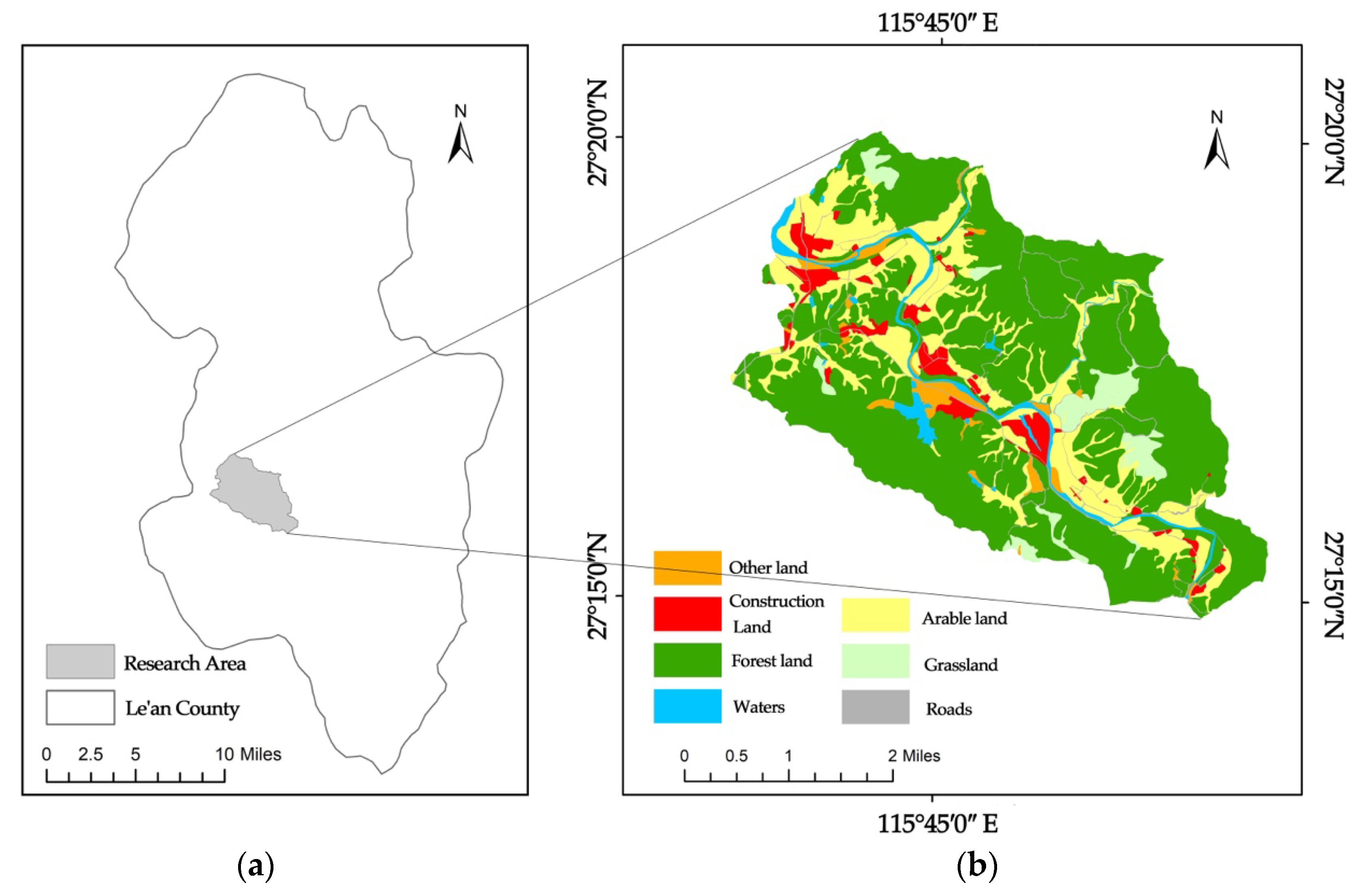
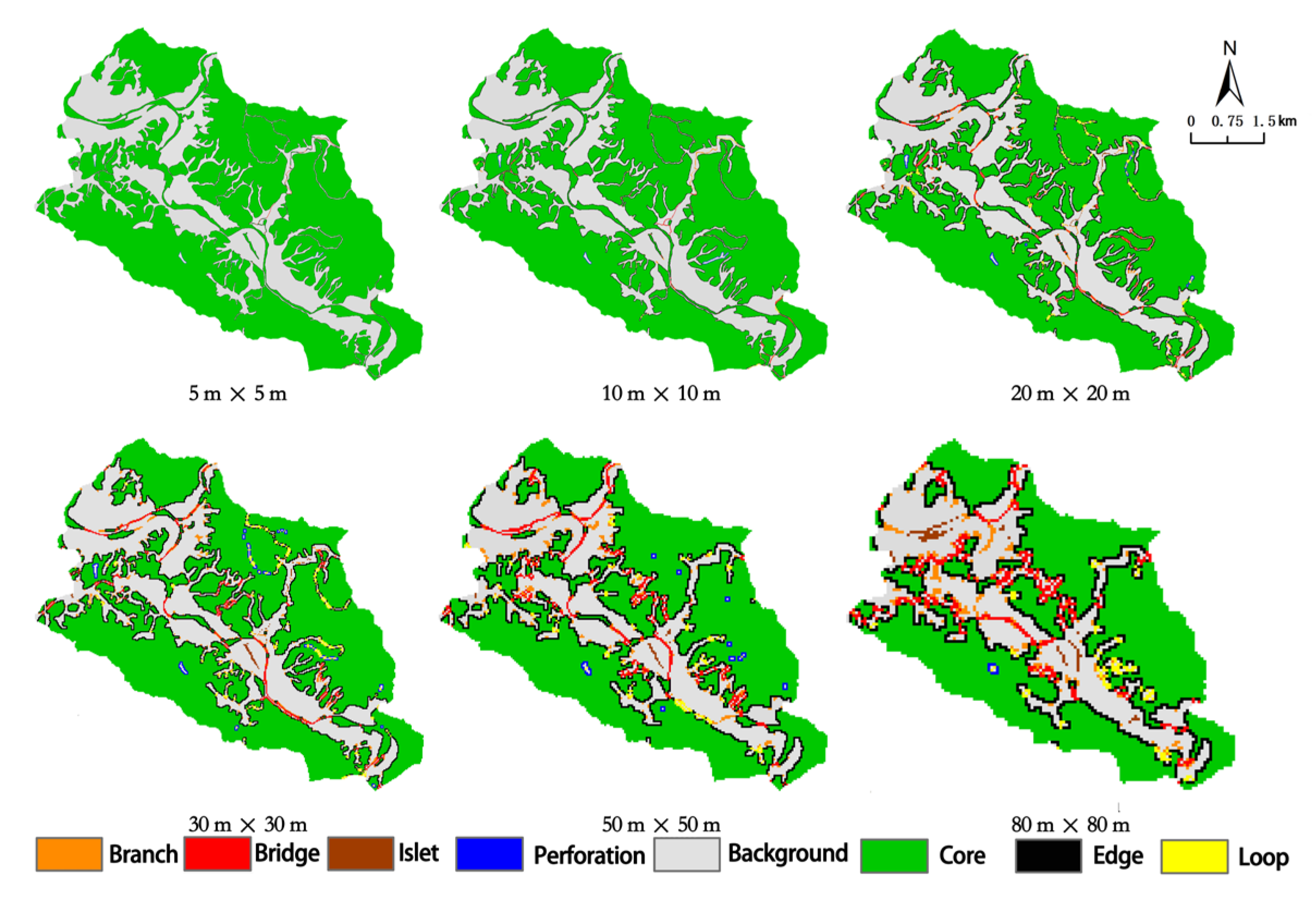
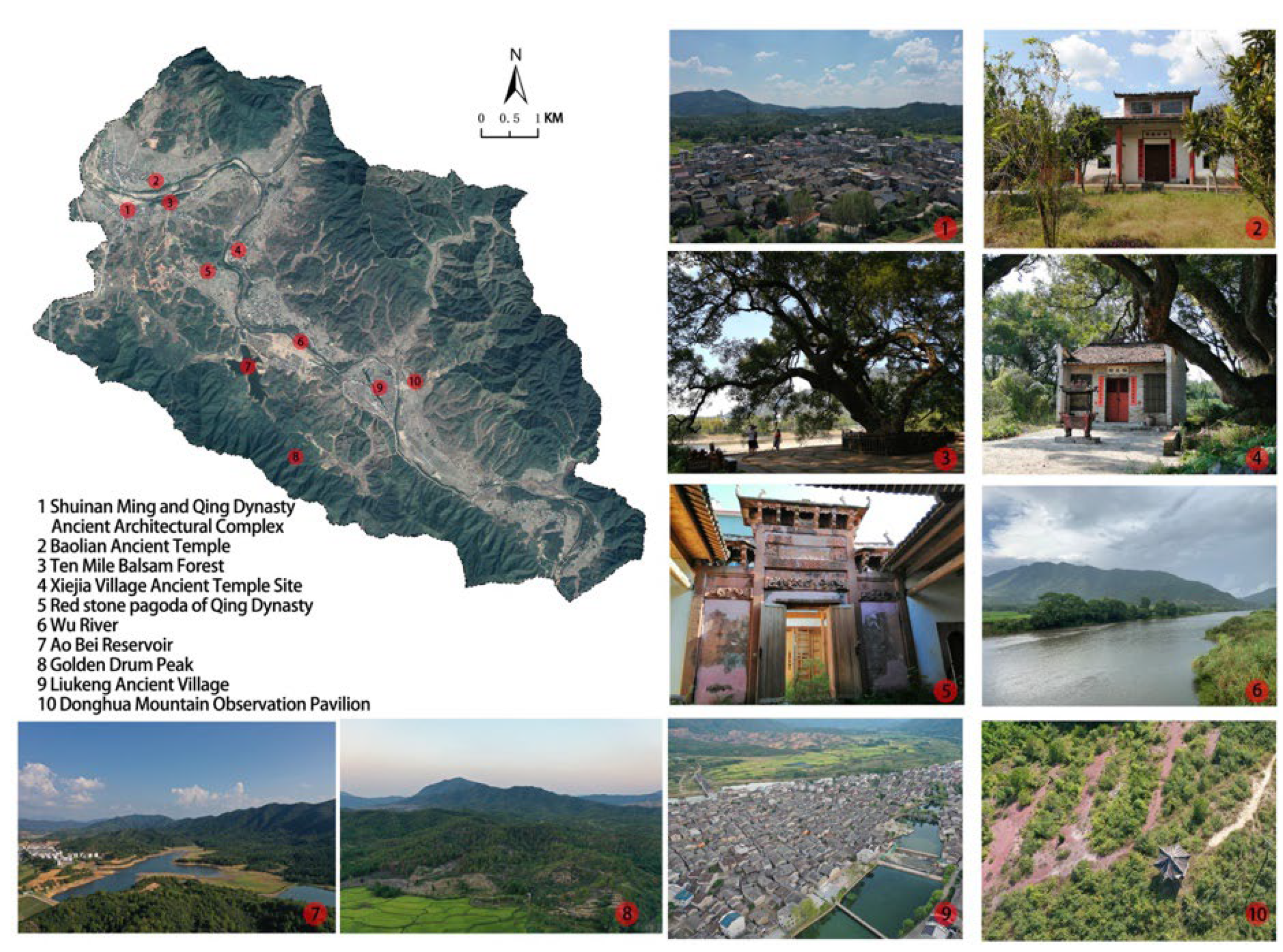
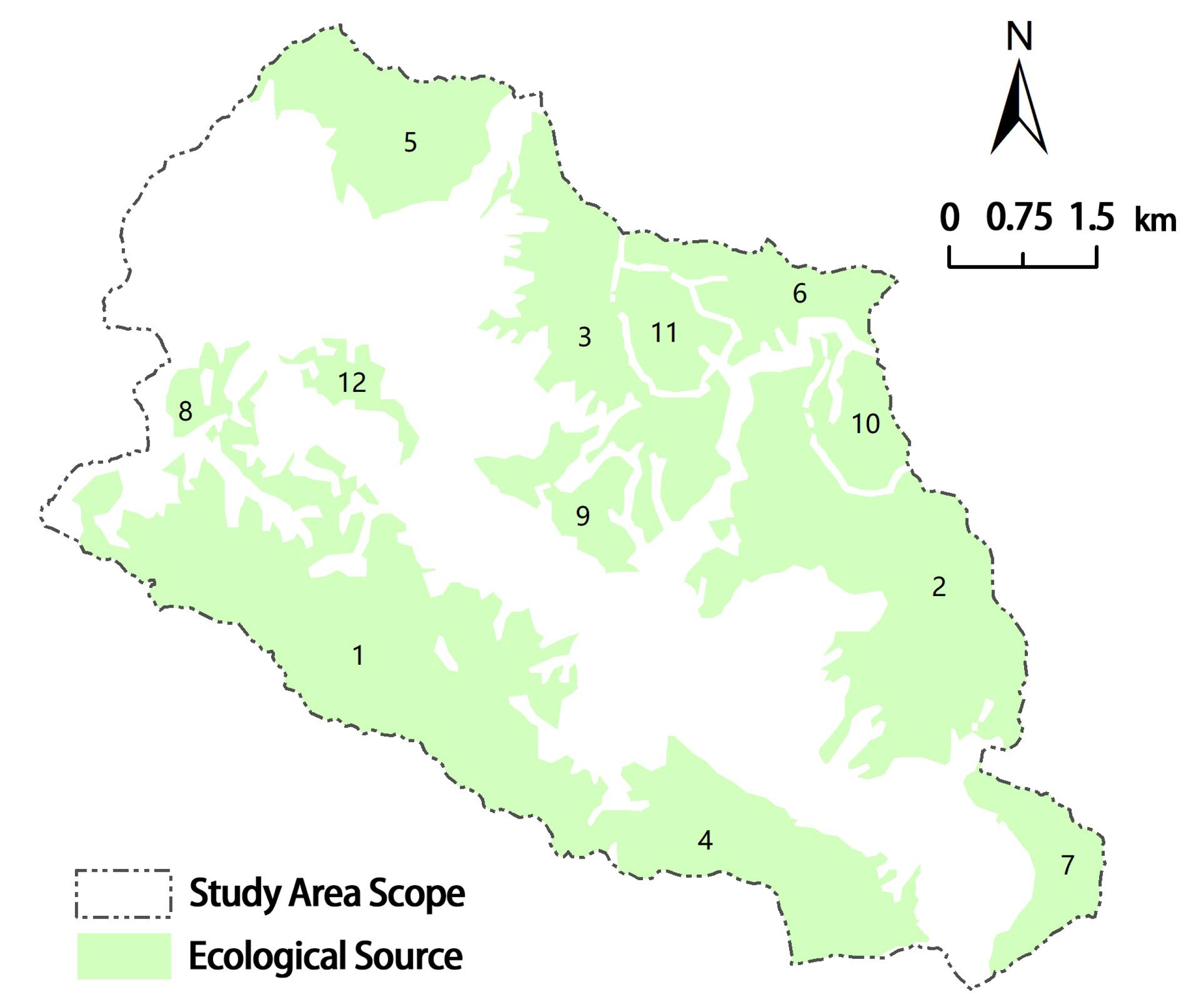
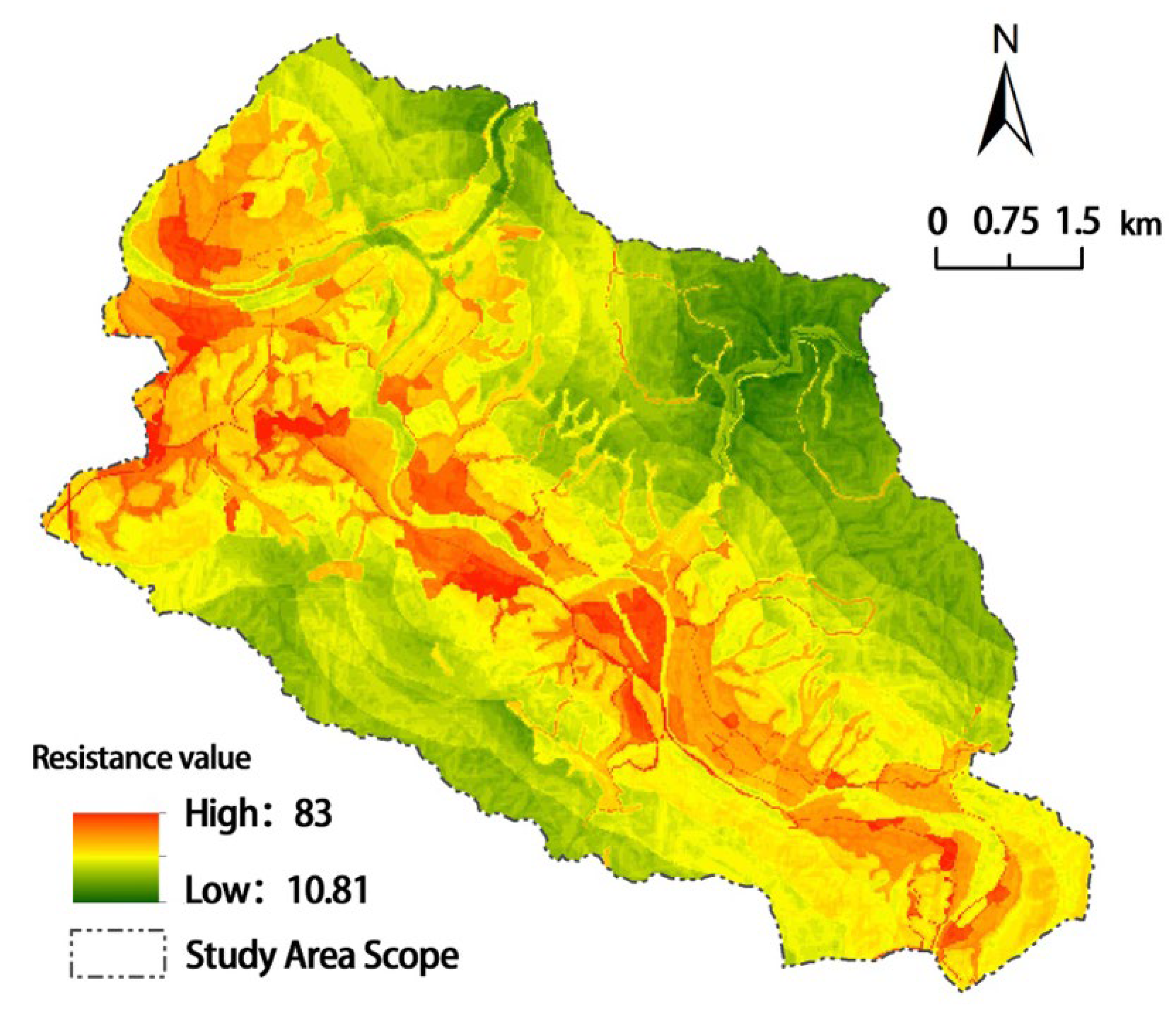
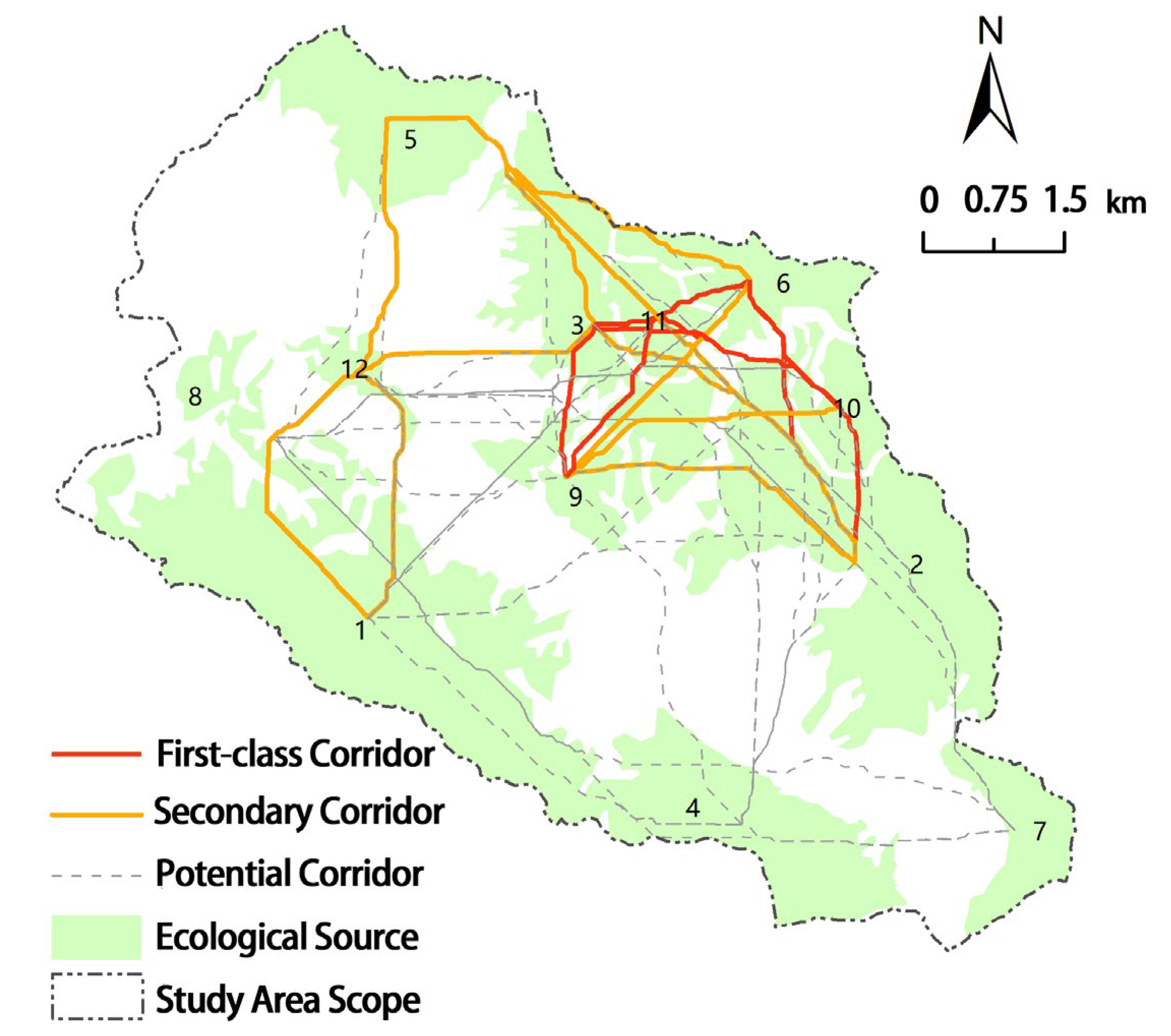
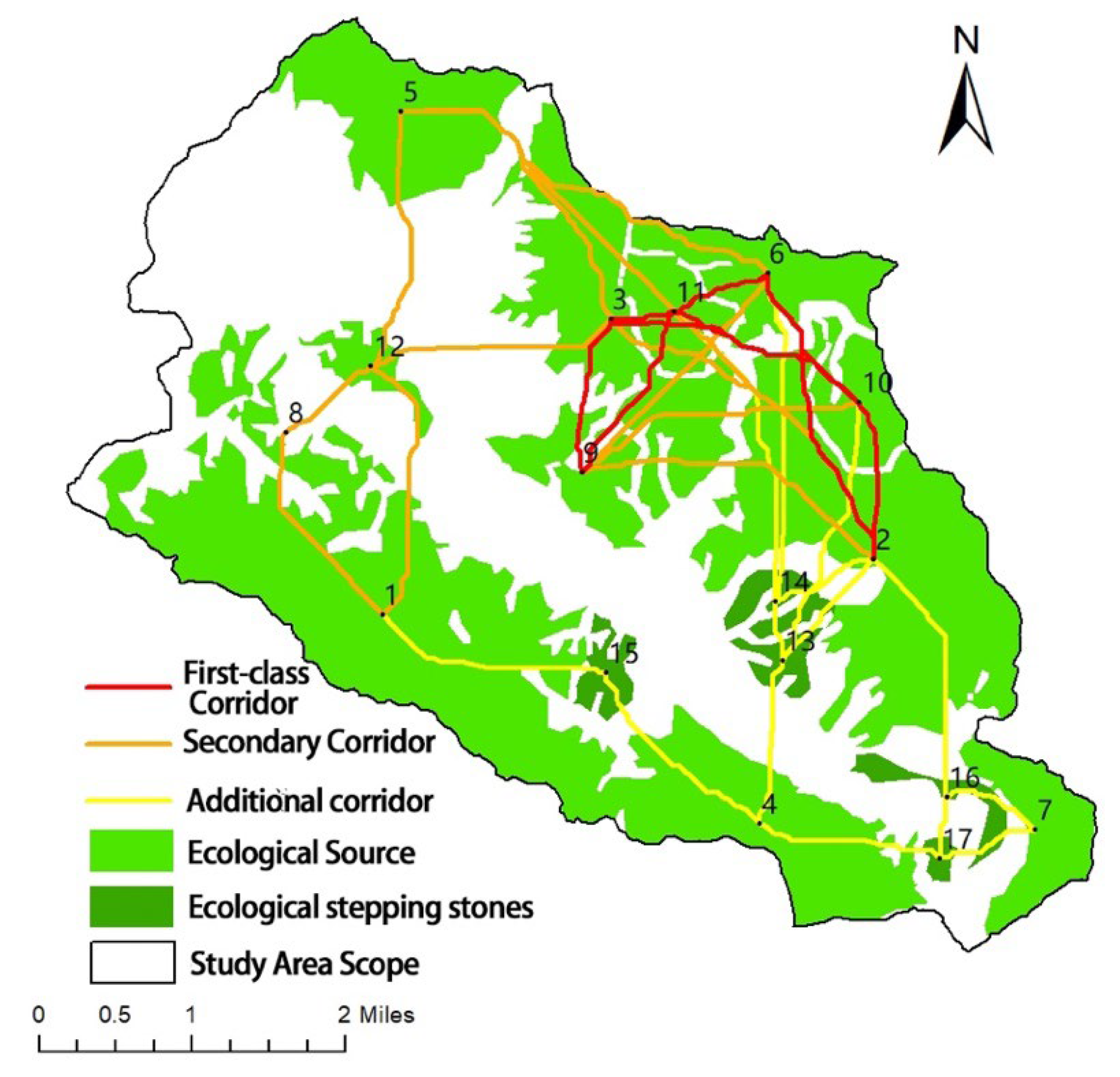
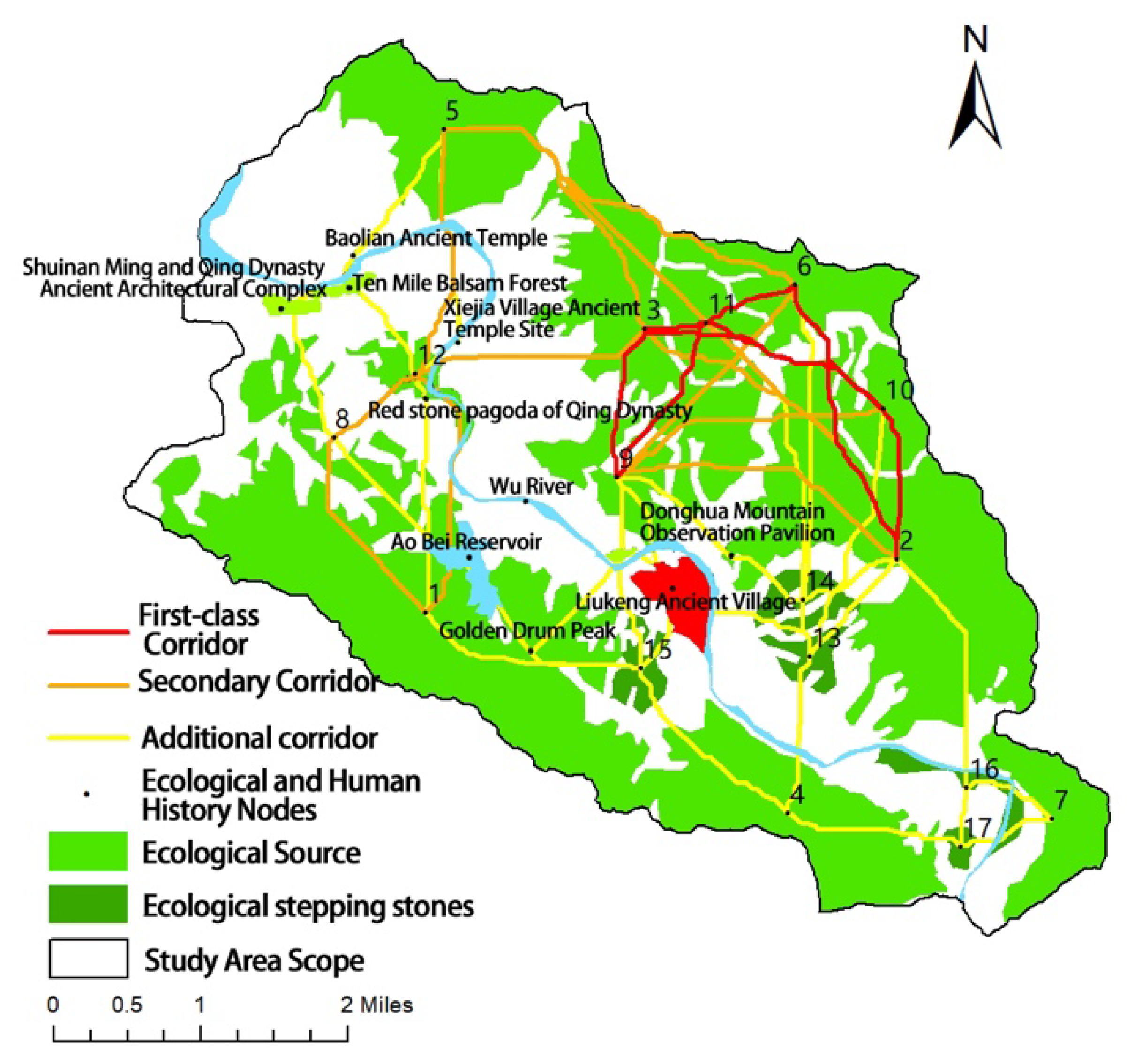
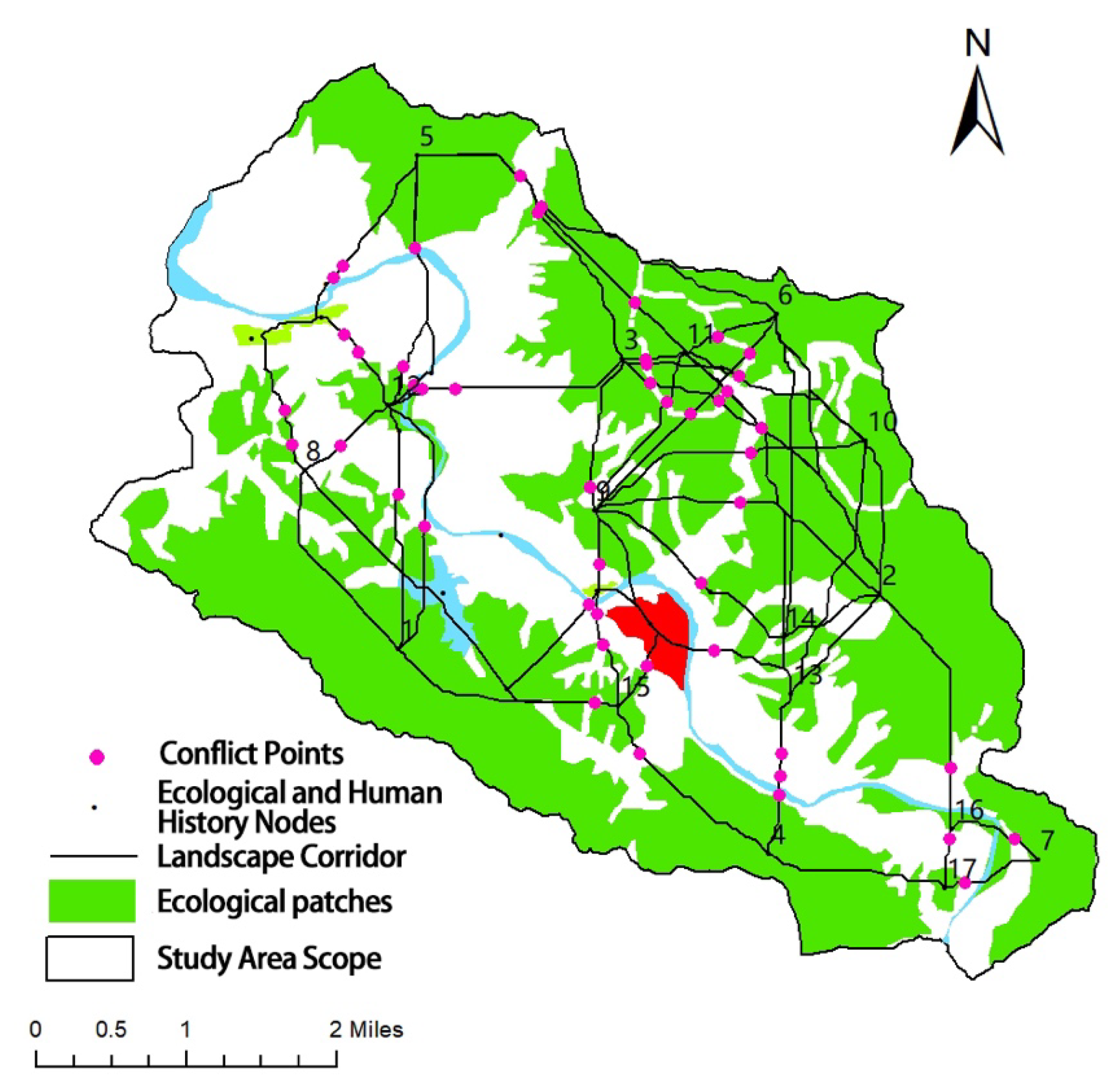
| Resistance Factor | Classification | Resistance Assignment | Weighting |
|---|---|---|---|
| Elevation (m) [41] | <100 | 10 | 0.08 |
| 100–150 | 30 | ||
| 150–200 | 50 | ||
| 200–300 | 70 | ||
| >300 | 90 | ||
| Gradient/(°) [42] | 0–2 | 10 | 0.11 |
| 2–5 | 30 | ||
| 5–15 | 50 | ||
| 15–25 | 70 | ||
| >25 | 90 | ||
| Land type [43] | Ecological source sites | 1 | 0.31 |
| Core | 5 | ||
| Bridge | 10 | ||
| Remaining forest land | 15 | ||
| Remaining grass and water | 20 | ||
| Arable land | 50 | ||
| Other Sites | 70 | ||
| Roads, construction land | 90 | ||
| Distance to residential area (m) [44,45] | >2000 | 10 | 0.27 |
| 1500–2000 | 30 | ||
| 1000–1500 | 50 | ||
| 500–1000 | 70 | ||
| <500 | 90 | ||
| Distance to highway (m) [45] | >1500 | 10 | 0.13 |
| 1000–1500 | 30 | ||
| 5000–1000 | 50 | ||
| 200–500 | 70 | ||
| <200 | 90 | ||
| Distance to waters (m) [46] | <100 | 10 | 0.1 |
| 100–250 | 30 | ||
| 250–500 | 50 | ||
| 500–1000 | 70 | ||
| >1000 | 90 |
| Landscape Type | Area/hm2 | % in Natural Landscape | % in Study Area |
|---|---|---|---|
| Core | 35.27 | 86.69 | 61.60 |
| Bridge | 0.27 | 0.67 | 0.47 |
| Islet | 0.03 | 0.08 | 0.06 |
| Perforation | 0.09 | 0.22 | 0.15 |
| Edge | 4.66 | 11.46 | 8.14 |
| Loop | 0.02 | 0.05 | 0.03 |
| Branch | 0.34 | 0.83 | 0.59 |
| Total | 40.68 | 100.00 | 71.06 |
| Patch Code | Patch Area (hm2) | Patch Code | Patch Area (hm2) |
|---|---|---|---|
| 1 | 7.522 | 7 | 1.286 |
| 2 | 6.280 | 8 | 1.172 |
| 3 | 3.423 | 9 | 1.028 |
| 4 | 3.336 | 10 | 0.930 |
| 5 | 2.610 | 11 | 0.908 |
| 6 | 1.583 | 12 | 0.506 |
| No. | 1 | 2 | 3 | 4 | 5 | 6 | 7 | 8 | 9 | 10 | 11 | 12 |
|---|---|---|---|---|---|---|---|---|---|---|---|---|
| 1 | 0 | 0.4337 | 0.7284 | 0.5996 | 0.4303 | 0.6777 | 0.1526 | 1.6643 | 0.9299 | 0.6042 | 0.6546 | 1.0348 |
| 2 | 0 | 2.0073 | 0.9181 | 0.5137 | 4.9874 | 0.8809 | 0.2282 | 1.2965 | 13.3124 | 3.3102 | 0.3891 | |
| 3 | 0 | 0.3016 | 1.5285 | 11.2314 | 0.2621 | 0.4845 | 4.6713 | 5.1801 | 36.9245 | 1.1612 | ||
| 4 | 0 | 0.1406 | 0.5130 | 0.5640 | 0.1813 | 0.3316 | 0.6385 | 0.3732 | 0.1645 | |||
| 5 | 0 | 1.5084 | 0.1243 | 0.4641 | 0.5549 | 0.9051 | 1.4047 | 1.1887 | ||||
| 6 | 0 | 0.4636 | 0.4202 | 3.2346 | 28.7948 | 43.2393 | 0.8180 | |||||
| 7 | 0 | 0.0649 | 0.1801 | 0.6285 | 0.3338 | 0.0916 | ||||||
| 8 | 0 | 0.4348 | 0.3391 | 0.3391 | 2.2437 | |||||||
| 9 | 0 | 2.5417 | 3.6956 | 0.9241 | ||||||||
| 10 | 0 | 11.2969 | 0.6265 | |||||||||
| 11 | 0 | 0.5114 | ||||||||||
| 12 | 0 |
Disclaimer/Publisher’s Note: The statements, opinions and data contained in all publications are solely those of the individual author(s) and contributor(s) and not of MDPI and/or the editor(s). MDPI and/or the editor(s) disclaim responsibility for any injury to people or property resulting from any ideas, methods, instructions or products referred to in the content. |
© 2023 by the authors. Licensee MDPI, Basel, Switzerland. This article is an open access article distributed under the terms and conditions of the Creative Commons Attribution (CC BY) license (https://creativecommons.org/licenses/by/4.0/).
Share and Cite
Hu, J.; Jiao, S.; Xia, H.; Qian, Q. Construction of Rural Multifunctional Landscape Corridor Based on MSPA and MCR Model—Taking Liukeng Cultural and Ecological Tourism Area as an Example. Sustainability 2023, 15, 12262. https://doi.org/10.3390/su151612262
Hu J, Jiao S, Xia H, Qian Q. Construction of Rural Multifunctional Landscape Corridor Based on MSPA and MCR Model—Taking Liukeng Cultural and Ecological Tourism Area as an Example. Sustainability. 2023; 15(16):12262. https://doi.org/10.3390/su151612262
Chicago/Turabian StyleHu, Jiaqi, Sheng Jiao, Huiwen Xia, and Qiaoyun Qian. 2023. "Construction of Rural Multifunctional Landscape Corridor Based on MSPA and MCR Model—Taking Liukeng Cultural and Ecological Tourism Area as an Example" Sustainability 15, no. 16: 12262. https://doi.org/10.3390/su151612262
APA StyleHu, J., Jiao, S., Xia, H., & Qian, Q. (2023). Construction of Rural Multifunctional Landscape Corridor Based on MSPA and MCR Model—Taking Liukeng Cultural and Ecological Tourism Area as an Example. Sustainability, 15(16), 12262. https://doi.org/10.3390/su151612262









